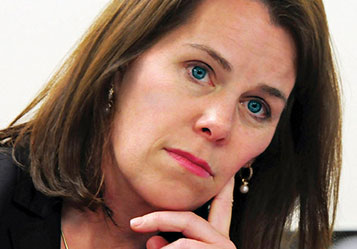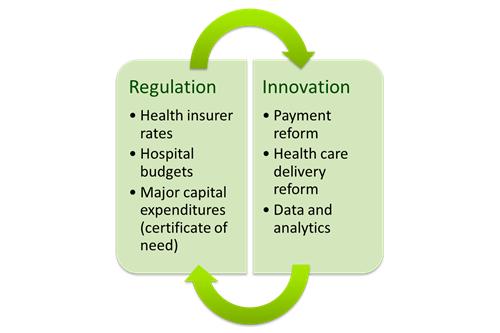Anya Rader Wallack and Healthcare Reform: Guiding One Big Elephant!
Vermont healthcare reform reminds me of the fable of the elephant and the blind men; comprehending the whole is tough. To do so, we need time to educate ourselves; attend or view the many public meetings; read hundreds of newspaper articles, blogs and reader responses; and pore over the state of Vermont's websites. Most of us cannot do that. We learn what we can through bits and pieces we pick up from passing conversations with friends who have encountered the elephant, or read snapshots in the news. I am a nurse. The piece of the elephant I see is the quality of health care delivered to patients: It is often rushed, and often dependent on medication and quick fixes, rather than long-term lifestyle teaching, or investing the time to sit and really listen to each patient's true needs. Primary care physicians try to meet their patient's needs in ten minute slots; specialists don't always have streamlined processes to receive or transmit information about whatever aspect of the client illness they have attended. Time Magazine's recent in-depth study on the rising cost of health care ("Bitter Pill," Feb. 20, 2013) shows the itemized bills of the insured, uninsured and the underinsured, charged for everything from two Tylenol to an MRI. The part of the elephant the healthcare consumer encounters can bring a lifetime of debt, bankruptcy or unrelieved poverty as a result of even one catastrophic hospital bill from delayed care or emergency treatment or chronic illness. Small business owners see another piece of the beast—and one that will manifest itself in January 2014, when a federally mandated exchange takes effect. Then, business owners must make thoughtful and informed decisions about whether to drop their current employee health coverage and instead encourage employees to purchase individual and family insurance (see sidebar). And middle-income families rightly ask how they can afford insurance premiums and out- of-pocket medical costs if they are in an income bracket ineligible for federal assistance? Affordable care for whom, they ask the elephant?
She intersperses academic jargon with slang like "stuff" and "sucks," punctuated now and then with an infectious laugh.A skillful MC at GMCB's public meetings, she moves the agenda, reflects on comments, and ensures that all voices are heard. Wallack, born in Calais and raised in Central Vermont, attended UVM for political science and received a Ph.D. in social policy from Brandeis University. She has worked for more than 20 years in healthcare reform, first with Howard Dean and then with Hilary Clinton. I asked her if she could recall any childhood influences that may have shaped her. "Not in healthcare reform specifically," she answered. "I grew up in a family with a strong awareness of public policy and politics. We read the paper every day, and my parents were involved in a lot of political issues. My mother worked in early childhood education and as a school librarian, and my father spent many years as a career counselor for Vietnam veterans, then as a city clerk in Burlington. He went to work for his college friend Bernie Sanders when he was mayor, and then in Congress. "I got into healthcare reform specifically because I was working with Howard Dean, and got assigned, without a whole lot of experience in the policy area, to be responsible for that chunk of his agenda. It quickly became a big part of his agenda. That was when Bill Clinton got elected, and he had his whole health reform plan. I just kept going deeper into it, and said, 'I guess I will become an expert.' Before that I was a generalist." ----------------------------------------------------------------------------------------------------------------- The Green Mountain Care Board's task, overseeing the state's ----------------------------------------------------------------------------------------------------------------- Balancing a Life Clearly Wallack has empathy for those of us who are not experts on the whole system, its fixtures and gears and jargon. I told her I had spent a few hours poring over articles and websites, and became overwhelmed and glassy-eyed over the sheer amount of information and the monumental task of it all. How did she not burn out? She laughed. "Who said I wasn't burnt out?" "But how do you take care of yourself? "I hang out with my dog. That's the best medicine," she answered. "I snowshoe, run, lift weights. Exercise is my main method for taking care of myself. It is an intense job. There is always too much work, and I have piles of stuff in my house I would like to read someday. And stuff I should read immediately. And they all keep growing." She said she found she could sustain the job, but the bigger stress came from being away from her family. Her husband and 12-year-old son live in Rhode Island. She and they have taken turns sharing the commute, she explained. "The first nine months I was here, they stayed there, and I would commute. Then last year, my son came up, and went to school here, and my husband commuted. And now they are both back in Rhode Island, and I commute." Does she ever not think about HCR? "Nope." So it's more than a full-time job. "I'd like to work just 40 hours. That would be nice," she smiled.
Public Input Wallack said the board was working on getting more input that isn't just off-the-cuff visceral, but thoughtful; already it had gotten good ideas. Each board member finds ways to stay rooted, whether it is staying in touch with small business people and the public they service, volunteering at a free medical clinic, or just reaching out to people who have different perspectives critical of the board's work. Board members bring that feedback into their board discussions. How have the turnouts been for the public meetings? Wallack said that so far public turnouts have varied, depending on the topic. They have public meetings at their conference room in Montpelier every Thursday, and get a full room, 20 to 30 people, most of the time. "We have had public forums for specific topics. We had one in Chittenden for business people to talk with us about how we do insurance rates, and I thought, we are only going to have three people, because who wants to come in the middle of the day to talk about insurance rate-making? And we had a full room, 50-ish. Great, great input. "We had one for hospital budgets last year on interactive TV, where people could go to sites around the state. That format didn't work so well. We are still testing these things out." She said her proudest accomplishment for 2012 was putting GMCB's regulations all into one place. It has begun to connect the system's separate pieces in a coherent way. "That's not a job that is done," she said, "but we made tremendous progress in terms of educating ourselves, and educating the folks who pay attention to our work. We have come a long way. We are almost a year and a half into our work, and we seem to have broad credibility. "Yeah, there are those that call us elitist and all-powerful, but in general the feedback we get is, 'You guys are doing good, hard work, we understand it, and we will give you more time to make this a success.'" "To me, maintaining our credibility, and being able to make this idea operational and functional and successful is something, because we could have found ourselves a year and a half out, and have everyone shouting at us, and people saying, 'You suck, and let's repeal this.'" ----------------------------------------------------------------------------------------------------------------- We have tried to incorporate in our work—and it's hard to do this— ----------------------------------------------------------------------------------------------------------------- The Elephant Ahead Clearly the legislature and Gov. Shumlin have not been displeased, for the most part. So what will 2013 hold for GMCB? Ah, which means? She gave as an example the latest version of the state's expenditure analysis and the need for accurate spending forecasts. She said the board has work underway "to really improve how we do forecasting of expenditures into the future. And that's a really important baseline to have when we implement things like payment reform." Wallack anticipates the new method will enable the board to evaluate its decisions, asking, "Did we change anything? What did we expect to happen without that? And what happened with it? And can we have a credible methodology for saying we changed the world, or we didn't, and be honest and transparent so people can understand how we are doing that? So that kind of data foundation is a huge front on which we are working." She calls their regulatory processes "a tool to both constrain the rate of growth and healthcare costs, and to influence where the money is going--not just saying we will only let so much money go into hospitals, but also trying to create some incentives for good investments, good changes—so hospitals are less focused on filling beds, and more focused on keeping populations healthy." Another area of focus is the health insurance rate review process. Again Wallack was looking for logical connections between data and the healthcare system's pieces. She said, "Up until now, there has been a real disconnect between a lot of the other health policy realms, and what happened to the rate review process. We've just kind of let the rates go. We are trying to hook that car onto the train, and make sure there is coherence." She uses a graphic to show how she sees regulation making Vermont more "smart and deliberate about what we are doing and, in our regulatory processes, using that information. I have this slide, which I love to use."
"That's our goal: to create the best healthcare system, so we can cover everybody, and afford it. And number two, while it's uncomfortable for people, nobody benefits from us just sitting back, and throwing up our hands, and saying this is too complicated, too hard, creates too many enemies, ruffles too many feathers. Everyone benefits from us moving forward with this agenda. But they may have to give us some control, or get out of their comfort zone." Where is Prevention? I told Wallack that whenever I read about preventive care as defined by insurance companies, I see breast cancer screening, vaccinations, colorectal exams. But for me, preventive medicine includes exercise and nutrition. When and where are these ever going to be addressed in healthcare reform? She answered that setting up expectations and incentives—for example, within the new Accountable Care Organization (See Vermont Woman, Winter 2013)—will drive providers away from more medicalized treatments to what really keeps a population healthy. She said the state's current expenditure analysis focuses on traditional medical expenditures "because that's what you track through the data sources we have used historically. It's mostly based on claims, and that's where the measures like breast screening are found." Right now, Vermont cannot easily track from any really good data source whether Vermonters eat right or exercise. She said, "We need to figure out some financial or business model that drives people to do that. We want CEOs or CFOs to say 'I don't care if people are using hospital services, because I have an incentive to do all sorts of things to keep them out of the hospital.' Right now, the model is exactly the opposite."
|
||||||||||
| Roberta Nubile, an R.N., lives and works in Shelburne. Look for her series on the GMCB members and their perspectives on healthcare reform in upcoming issues of Vermont Woman. | ||||||||||
1. Vermont Healthcare Reform: Guiding One Big Elephant! by Roberta Nubile , April/May 2013 3. GMCB’s Al Gobeille: The Voice of Business in “Health Connect” by Roberta Nubile, September/October 2013 More articles in this series will be forthcoming in the Nov/Dec 2013 and Feb/Mar 2014 of Vermont Woman |
||||||||||

